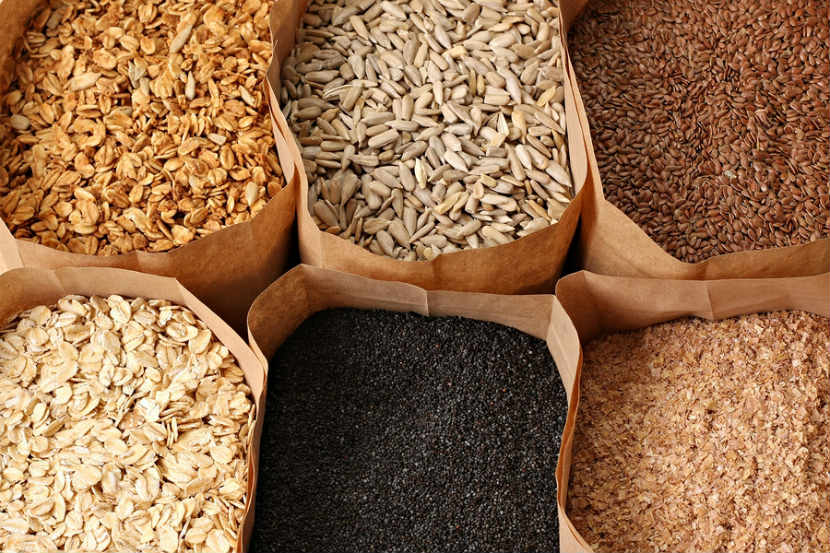
Health Canada recommends that all Canadians should aim to get at least half of their grain servings as whole grains. This means 3-4 whole grain servings per day depending on your age and sex. Whole grains are versatile and tasty but it may be challenging to figure out how to get more into your diet. Read on for tips on buying and preparing whole grains.
What are whole grains?
Whole grains are grains which have undergone the least amount of processing. This means that all three parts of the grain are preserved, including the bran, germ, and endosperm.
The bran is the protective covering of the grain and provides fibre, B vitamins, and minerals.
The germ nourishes the seed and is the source of new growth in the plant. It provides mostly vitamins, including B vitamins and vitamin E, minerals and healthy fats.
The endosperm is the inner seed and provides carbohydrate and protein. It also provides vitamins and minerals.
Buying local whole grains
If your product package does not have a Foodland Ontario logo or list where the grains were produced, you can call the manufacturer to find out. If you buy your grains in bulk, ask your store manager. Buying local food helps to support farmers so they can continue to produce high quality, nutritious and affordable food.
Don’t be fooled!
Surprisingly, in Canada there are no regulations for using the term "whole grain" on product labels. That means the term "whole grain" does not guarantee that the product is a healthy choice. Many products using the claim "whole grain" are in fact very low in whole grains.
How do I know I am getting a whole grain product?
Choosing whole grains can be easier than you think if you check the ingredient list on food labels. To make sure whole grains are the main ingredient, they should appear first on the ingredient list. Look for ingredients like "whole grain whole wheat flour", “whole rye”, “whole oat” or “oatmeal”, "whole corn”, “whole barley” and other grains that start with “whole”.
Don't be fooled by multigrain products, which may include a variety of different grains but may not include whole grains.
What about whole wheat?
Whole wheat is usually a refined grain, though there are exceptions. Refined grains are grains that have had some or all of the germ and bran removed from the kernel. Examples of refined grains are white flour, white rice, white pasta, whole wheat flour, and cream of wheat cereal.
Whole wheat flour contains at least 95% of the wheat kernel, but most of the germ and some of the bran is missing. Therefore, products labelled as 100% whole wheat or 60% whole wheat are NOT whole grain products.
The ABC’s of some popular whole grains
Wondering what to choose at the grocery store, or how to use some different grains? Try some of the following whole grains.
Amaranth*
-
tiny, circular grain
-
cream-colour
-
store in a tightly sealed container, in the refrigerator
-
mild, sweet, nutty flavour
-
try boiling it as hot cereal, or ground into flour for breads, muffins, pancakes, and pastas, popped like popcorn, or toasted in a stir-fry
Bulgur
-
produced from wheat
-
ranges in colour from cream to brown, similar in appearance to sunflower seeds
-
store in a tightly sealed container, in the refrigerator
-
has a mild nutty flavour
-
since it’s precooked, it is quick to prepare as a side-dish, pilaf or salad
Millet*
-
tiny, circular granules
-
colour ranges from white to gray to yellow to red
-
store in a tightly sealed container, in the refrigerator
-
slightly sweet, nut-like flavour
-
is used as a side dish similar to couscous or rice, or for hot breakfast cereal
Quinoa*
-
small, circular granules
-
pale yellow in colour
-
store in a tightly sealed container, in the refrigerator
-
slightly nutty flavour
-
used as a side dish, in soups, as a base for salad, or cooked as hot cereal
Spelt
-
oval in appearance
-
yellow-brown
-
store in a tightly sealed container, in the refrigerator
-
deep nut-like flavour
-
a distant cousin to wheat, it can be ground into flour to be used in breads, baked goods, and pasta, but it can also be prepared as an alternate to rice
Triticale
-
a hybrid between wheat and rye, and looks similar to both grains
-
comes as cracked, flaked or as flour
-
store in a tightly sealed container, in the refrigerator
-
a substitute for both rye and wheat in recipes and can be used in breads, muffins, pasta, waffles, and cereals
Other whole grains include barley, brown rice*, buckwheat*, corn*, kamut, oats, rye, sorghum, and wheat
*gluten free whole grains
Preparation
|
Whole grain (1 cup)
|
Amount of water
|
Bring to a boil, then simmer for
|
Cooked amount
|
|
Amaranth
|
2 cups
|
20-25 minutes
|
3 1/2 cups
|
|
Bulgur
|
2 cups
|
10-12 minutes
|
3 cups
|
|
Millet, hulled
|
2 1/2 cups
|
25-35 minutes
|
4 cups
|
|
Quinoa
|
2 cups
|
12-15 minutes
|
3+ cups
|
|
Spelt
|
4 cups
|
soak overnight then cook 45-60 minutes
|
3 cups
|
|
Triticale, flaked
|
2 cups
|
12-15 minutes
|
2+ cups
|
Recipes:
Vegetable and Quinoa Salad
Quinoa and Lentil Pilaf
Chicken Bulgur Salad
For more information:
Choosing Whole Grains FAQ
Whole Grains 101, Whole Grains Council
Last Update – July 12, 2017